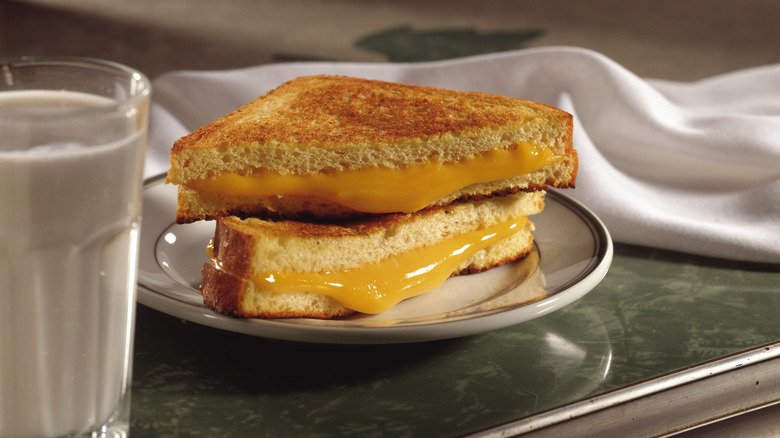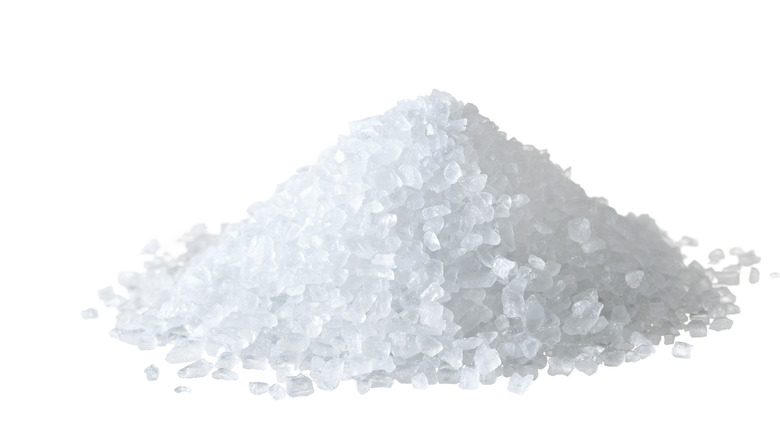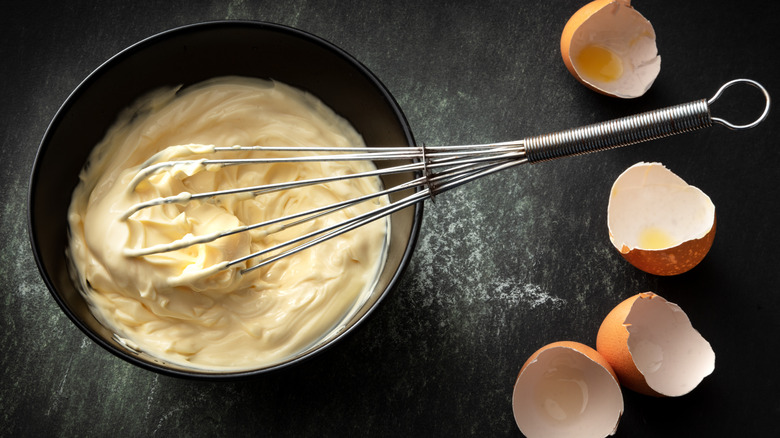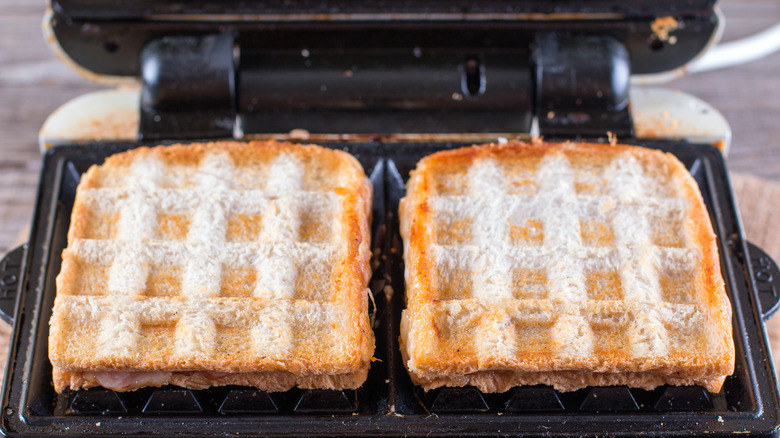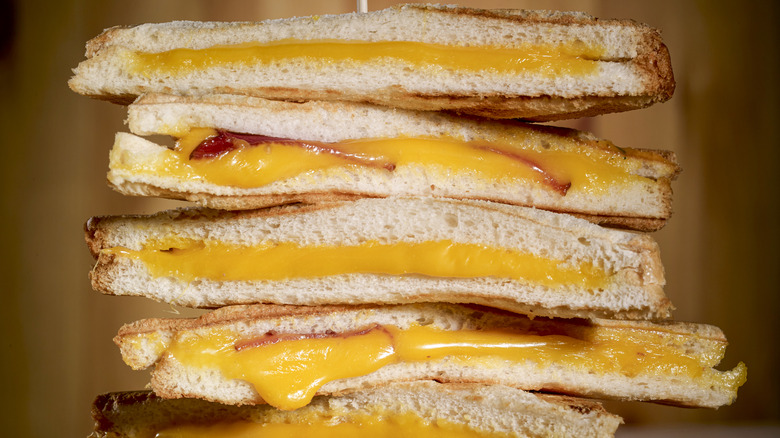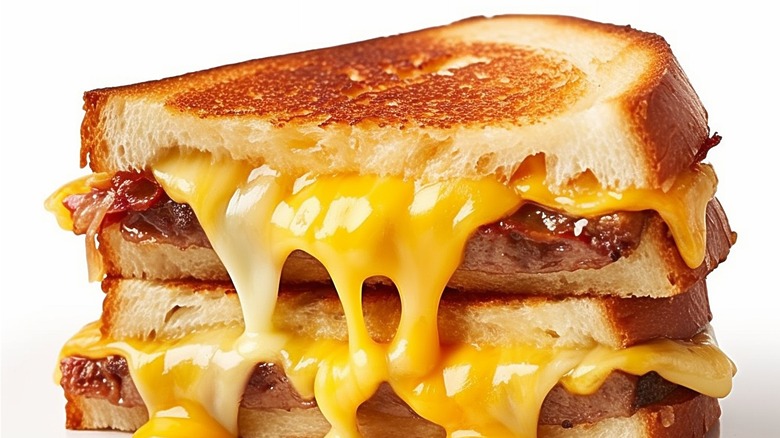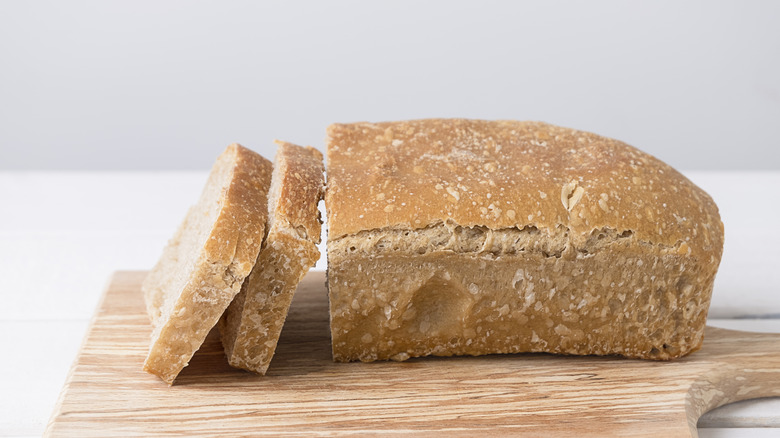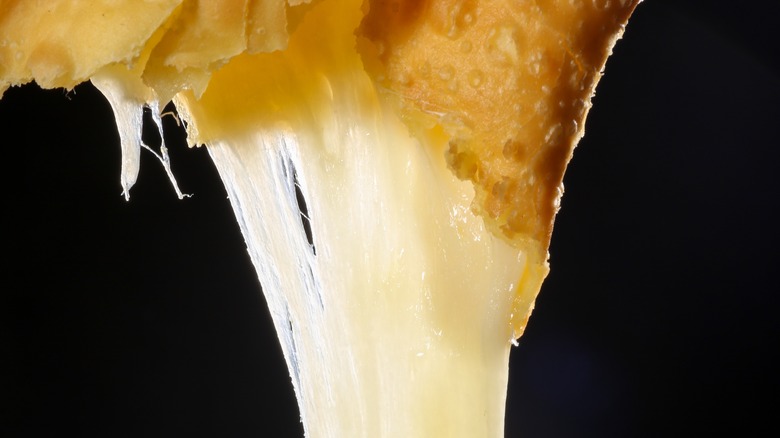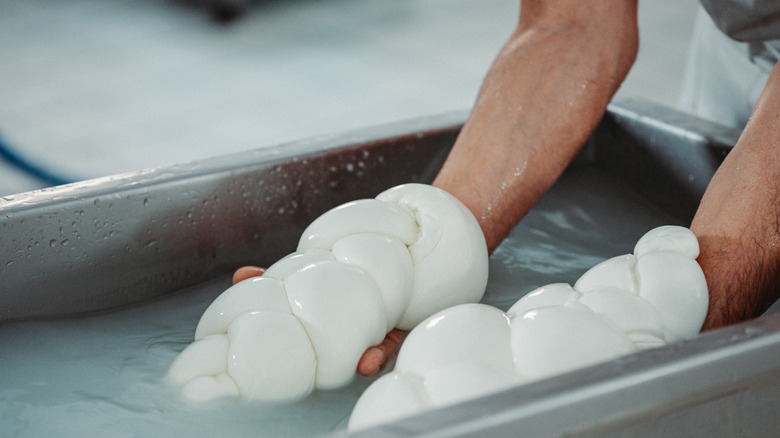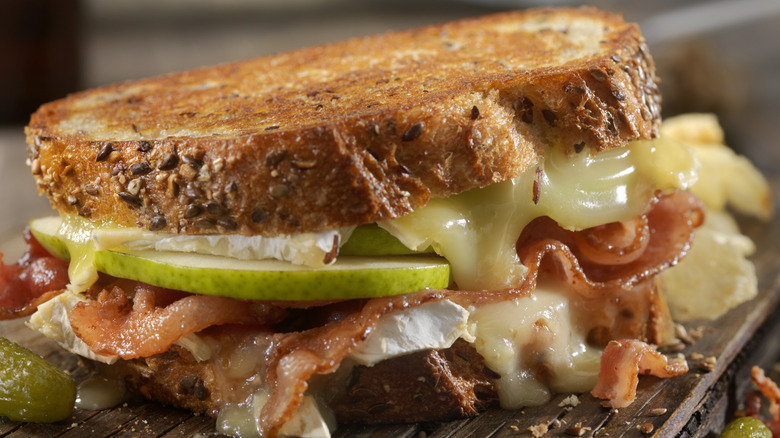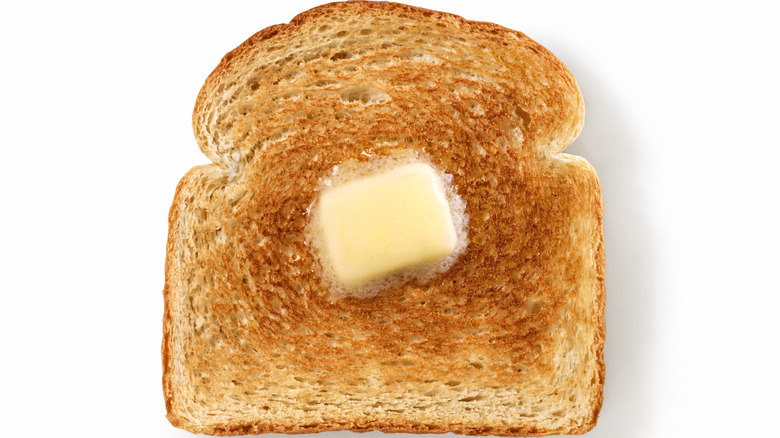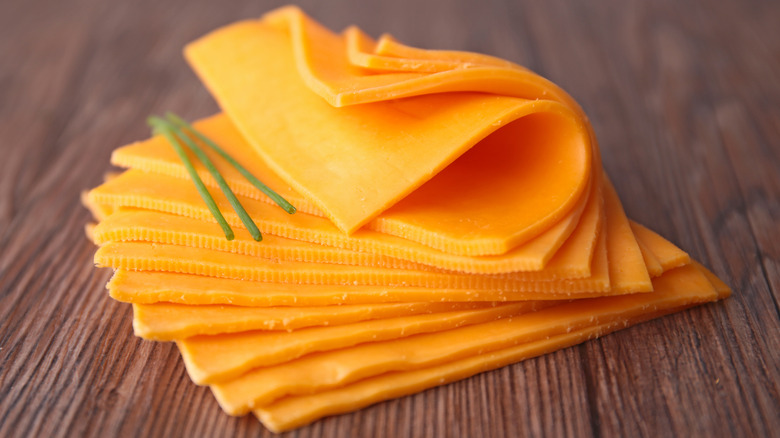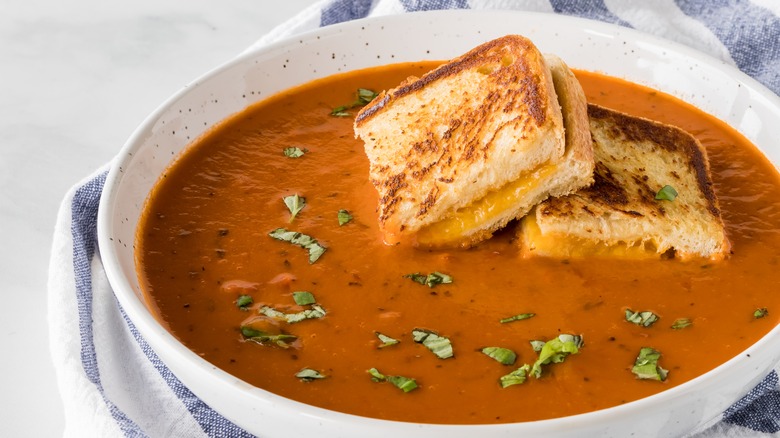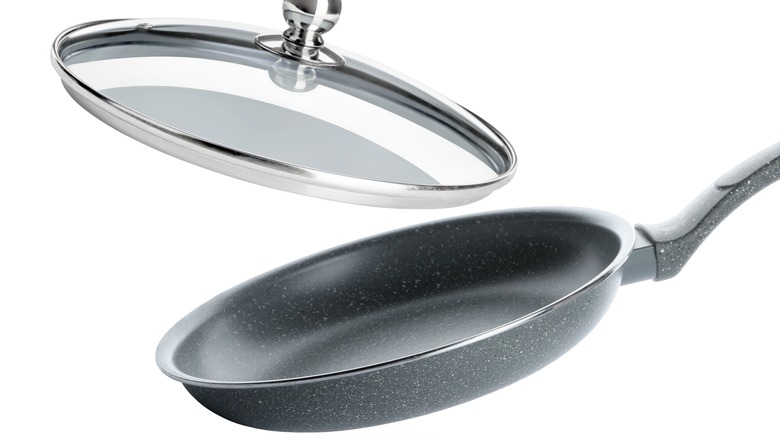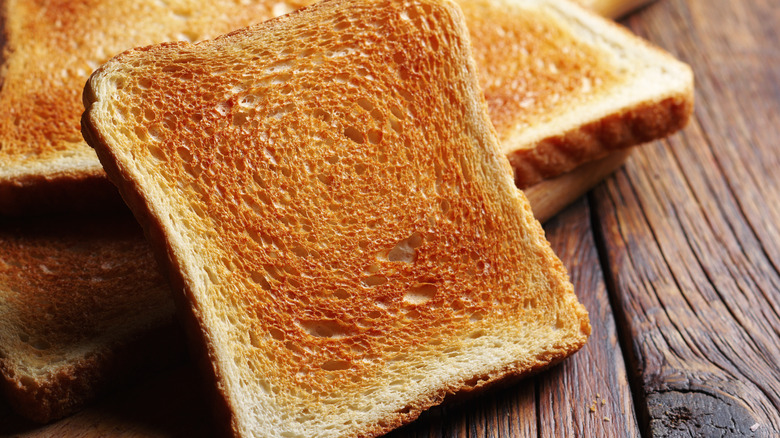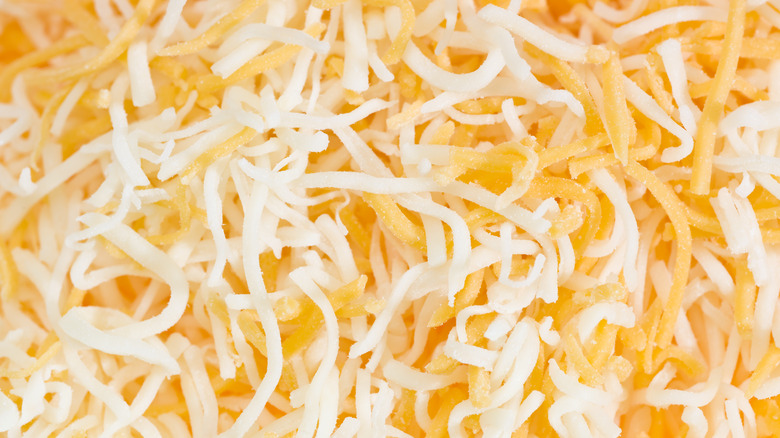15 Ways You've Been Making Grilled Cheese All Wrong
Grilled cheese is a bit like pizza: Even when it's mediocre, it's still pretty darn good. But there are a few tips and tricks that will take your sandwich from two slices of bread with cheese to a perfectly crispy, gooey, salty, golden sandwich every time. Just two simple ingredients — bread and cheese — are the building blocks of one of the greatest sandwiches of all time. Ooey, buttery, and crisp, the grilled cheese is one of the easiest hot sandwiches to make.
But even though it's simple, it can still be elevated to new heights with proper technique and tips. Sure, melting cheese on bread will taste good (how could it not), but making a proper grilled cheese in all its gooey golden glory requires understanding how to tease flavor and texture. Perhaps because it's so simple to throw together without a recipe, home cooks often make the same mistakes when preparing their sandwiches. Knowing how to avoid these mistakes is the key to grilled cheese nirvana.
You're not salting your skillet
Sure, you can rely on the salty cheese to season your sandwich. But any great chef understands that seasoning is the key to a great dish. Seasoning isn't just about the quantity of salt; it's also about how the salt is applied to a dish. This is why chefs sprinkle salt from high above a skillet — the salt disperses better, creating a uniformly seasoned dish.
The same applies for a grilled cheese. If you salt the skillet when you add your fat of choice, the salt will disperse within the fat. When you add the sandwich, the salted butter or oil will evenly season the bread. The result? Perfectly seasoned crispy bread in every bite.
You're not using mayonnaise
Throw some butter or oil into a pan, add your bread and cheese, and you'll end up with a serviceable grilled cheese sandwich. But if you spread a light swipe of mayo on the outside of each bread, you'll be rewarded with a highly improved sandwich. For starters, mayonnaise has a higher smoke point than butter, allowing your bread to stay perfectly toasted at a hotter temperature without burning.
Mayonnaise also contains ingredients — seasoning and vinegar — that add more nuance to your grilled cheese. The slight vinegary tang of mayonnaise is especially useful when cutting through the richness of the sandwich. One final benefit to using mayonnaise: It's much easier to spread than butter, so you can ensure a uniform application, which will encourage your sandwich to cook evenly. The idea of using mayonnaise has been touted by people like Ina Garten and was popularized by chefs such as Melissa Hamilton and Christopher Hirsheimer in their 2011 cookbook.
Not thinking outside of the pan
A grilled cheese requires heat, but there's no rule about how that heat should be applied. Instead of turning to your stovetop and skillet (or grill pan), look for other heat sources. If you're after a gorgeous golden exterior, pop your sandwich into the air fryer. Best and easiest of all, cook your grilled cheese in a waffle iron. Forget the name and think of a waffle iron as a miniature oven or grill, albeit one where the heat is even, predictable, and uniform. The divots of the iron will create a deliciously crisp waffled pattern on the surface of your sandwich and will make particularly golden edges.
Before cooking your grilled cheese in the iron, be sure to still apply a layer of butter (or mayonnaise) to the outside of the bread. To create extra crispy edges, press down and apply some heat to the heat during cooking, which will also speed up the rate of melting the cheese. The other benefit to the iron is that it cooks from top to bottom, unlike a skillet or grill pan, which will ensure that your cheese melts just as your brown gets toasty and golden brown.
Not using the right tools for big batches
Making grilled cheeses for a crowd? Rather than sweat over a skillet, making sandwich after sandwich, turn to your oven for an easy solution. Place all of your sandwiches on a large sheet pan, taking care to oil or butter the bread as usual, and bake them. The cheese will melt as the bread toasts, leaving you with an entire pan of golden, gooey sandwiches.
For best results when baking a big batch of grilled cheeses, keep the oven heat around 350 F and don't overcrowd the pan. Rotate the pan halfway through cooking, keeping an eye on the sandwiches for doneness. It's best to bake your sandwiches on the middle rack of your oven so they aren't too close or too far from the heating element. If you have a convection oven, use that setting to circulate the heat better.
Your heat is too high
Yes, waiting for the cheese in your grilled cheese to melt is a total drag, especially if you have a hungry crowd (or ravenous toddlers) clamoring for their lunch. But don't commit the mistake of simply cranking up the heat to speed up the process. You're aiming to have the cheese melt in the very center just as the bread is reaching a deep golden brown color. If you raise the heat too much, the bread will burn before the cheese has time to fully melt. Ideally, a grilled cheese sandwich will take between 5 and 7 minutes to cook when the heat is properly calibrated.
Start with your pan over medium heat, and drop it to medium-low towards the second half of the cooking time. Don't skip the fat either: Coating the outside of your bread with butter or mayonnaise, as discussed above, will act as a shield against the heat, protecting the bread from burning. If you're really pressed for time, cover your skillet or pan with a lid. This will trap the heat, effectively creating a small convection oven, and will speed up the cheese-melting process without increasing the heat on the bottom of the bread.
You picked the wrong bread
The gooey factor of grilled cheese is one of its finest attributes, but it also demands a certain type of bread. With all that melty cheese, you need to select a bread that has the proper structure. Artisan breads, like many sourdoughs or a ciabatta, are often riddled with holes (thanks to all that great fermentation activity), which won't work well with molten cheese. And on the other end of the spectrum, you don't want a Wonderbread-style loaf that's too soft. If the bread is too soft, it won't be able to stand up to the cheese, and you'll end up with a floppy sandwich rather than a crisp one.
Look for a loaf with a uniform crumb structure, like a white or wheat sandwich bread. If you want to up the ante with bread with more flavor, look for rye bread or a miche. Artisan breads aren't entirely off the table; just be sure you look carefully at the interior first. Once you decide on a bread with the right structure, consider the cheese pairing, too. Some cheeses work best with a milder, less assertive bread, whereas you might opt for something smokier if you have a sweeter bread like a brioche.
Your cheese isn't a good melter
If your cheese doesn't melt well, nothing can save your grilled cheese. There's a reason cheddar is one of the most reached-for cheeses for this sandwich: It melts evenly and quickly. To know how to select a cheese, you should start with an understanding of which cheeses melt well (and why). Cheese is a combination of fat (dairy) and water bound together in a structure of proteins. Under high heat, those protein structures begin to loosen, causing the cheese to melt. Water weakens the protein structures, which is why softer cheeses that contain more water melt more easily and at lower heat than harder ones.
Acidity also affects the melting quality of a cheese. Too high, like feta, or too low, like Parmesan, and the cheese doesn't melt well or readily. Cheeses like mozzarella fall right in the middle and are ideal for melting. Look for a cheese that isn't too soft but has a relatively high moisture and fat content. Gouda, cheddar, Monterey Jack, and Gruyere are all excellent options.
You didn't combine cheeses
Figuring out which cheese melts well is just the start. Most basic grilled cheeses will use a single cheese, like cheddar or American, but to really take things up a notch, use a medley of cheeses. Combining cheeses allows you to balance flavors: earthy smoked Gouda with a creamy Havarti or a robust aged cheddar with a mild, smooth fontina. Choose a combination based both on flavor and texture. Pick a good melting cheese, like fontina, Gruyere, or cheddar, as your base.
If you want a seriously stretch cheese pull, add in some mozzarella. Mozzarella stretches more spectacularly than other cheeses because of the manufacturing process. When mozzarella is put into hot, salty water, the process stretches the proteins into long strands, continually pulling and tugging them into stretchy shapes.
You didn't add a flavor twist
Cheese and bread are technically all you need to make a grilled cheese. But don't overlook the potential for flavor variations with add-ins. From crumbled bacon to sweet pickle relish to soft, caramelized onions, the options go on and on. Grilled cheese is a salty, golden blank canvas. Think about the style you want and the cheese you're using, and go from there.
A mild cheese like gouda is beautiful with a swipe of fig jam. Make a Caprese-style sandwich by adding a little fresh basil and chopped sun-dried tomatoes to a mozzarella-based grilled cheese. Apples and cheese are a perfect marriage: Layer some thinly sliced apples into a cheddar grilled cheese. And, of course, there's rarely a sandwich that isn't improved by a few slices of crunchy bacon.
You're ignoring the inside of the bread
You know that buttering (or applying mayonnaise to) the outside of your bread is essential. This creates a shield to protect the bread from burning in the heat of the pan, and ensures the fat is distributed evenly. However, deviating from the standard procedure of coating the outside of the bread has a big payoff.
Before building your sandwich and adding the cheese, apply a thin swipe of butter or mayonnaise (or even olive oil) to the inside of each slice of bread. This adds a barrier between the bread and the melting cheese, keeping the bread from getting soggy against the cheese as it melts. It adds an additional kick of richness and flavor as well.
Your cheese is too thick
We've all been there: Hastily slicing slabs of cheese for a sandwich, then cranking up the heat in the hopes that it melts. The result is a sandwich with unmelted cheese in the very center. To ensure that the cheese cooks evenly in parallel with the bread, slice your cheese as thinly as possible. The thinner the cheese, the more quickly it will melt. Not only should the cheese be sliced thinly, but it should be distributed uniformly around the bread rather than piling too much towards the center. The most important thing to keep in mind here is consistency: You want the cheese to be the same thickness throughout the sandwich to ensure even cooking.
Not considering other forms
Grilled cheese is so good that it shouldn't be confined to a basic lunch sandwich. The crisp-meets-gooey texture and the salty, buttery flavor are an excellent partner for a traditional tomato soup or any soup, but they don't have to be served on the side or merely dipped into the soup. To use a grilled cheese for more, think about other shapes. Slice a grilled cheese into small squares, frying them if you want to really gild the lily, and use them like croutons. Pile them on top of a bowl of soup. After all, there's a reason the crisp bread and gooey cheese on top of a French onion soup is so irresistible. Or toss them into a salad in place of a classic crouton. A Caesar salad is a good application for these cheesy croutons, or use them instead of plain bread in a panzanella.
Forgetting to use a lid
To nail the cooking on a grilled cheese, you need to have high enough heat to get a golden crust while giving the cheese time to melt. Putting a lid on top of your pan or skillet will speed up the cooking time for the inside of the sandwich since the trapped heat circulates around the entire pan, rather than toasting only from the bottom up. If you're using a grill pan, you can cover it with a large sheet pan to get the same effect.
If you really want to lean into this method, you can make your grilled cheese open-faced and cook the two slices of cheese-topped bread side by side in a pan. Adding the lid on top will make the cheese melt at the same time as the bread toasts, and then you can sandwich them together just before serving.
Not toasting the bread
Toasting the bread is one more way to take your sandwich to another level. Before you spread it with butter or mayonnaise or oil, lightly toast each slice. Don't go too dark here, as the exterior will already get toasted in the pan. However, a light toasting of the bread will prevent the interior of the sandwich from getting soggy as the cheese melts, ensuring maximum crispiness for your sandwich. It can also help the cheese melt more quickly since the inside of the bread will be warm.
You chose pre-shredded cheese
One way to avoid the problem of slicing your cheese too thick is to opt for shredded cheese. Since the cheese is in much smaller pieces when shredded or grated, it'll melt much more quickly. But don't be tempted to go for total convenience and reach for a bag of shredded cheese.
Pre-shredded cheese is tossed with cellulose, an anti-caking agent that keeps cheese in a bag from melting or drying out. Instead, buy a block of cheese and grate it yourself. The small amount of extra effort is worth the difference in result. The cellulose in pre-shredded cheese inhibits the meltability and can also negatively affect flavor.
